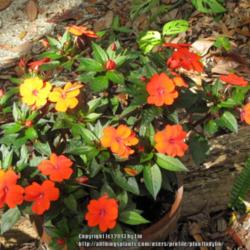| I just bought a beautiful New Guinea Impatiens and I have it hanging outside. Please tell me about it. What it likes, growing habits, soil preference, moisture, light, etc. Also, do I need to fertilize it? If I was to plant it in the ground, would it come back next year? How do I prepare it for winter? How do I start new plants from this one? Seeds or cuttings? Thanks so much for your help. |

New Guinea Impatiens is a popular houseplant that will bloom all winter long if its needs are met. Here are some handy hints for keeping your plant happy while indoors: Provide average household temperatures, minimum of 55F in winter. Give bright light, with a few hours of direct sunlight in the winter to promote flowering. Keep potting soil moist but not soggy wet. Mist leaves if the air is dry but don't get water on flower petals or they will become spotted. Repot in the spring, using fresh potting soil. You can take stem cuttings or divide the roots in spring to propagate your plant. |